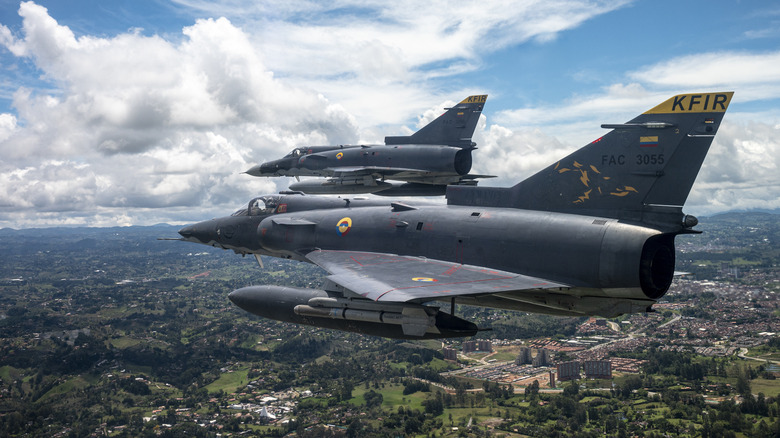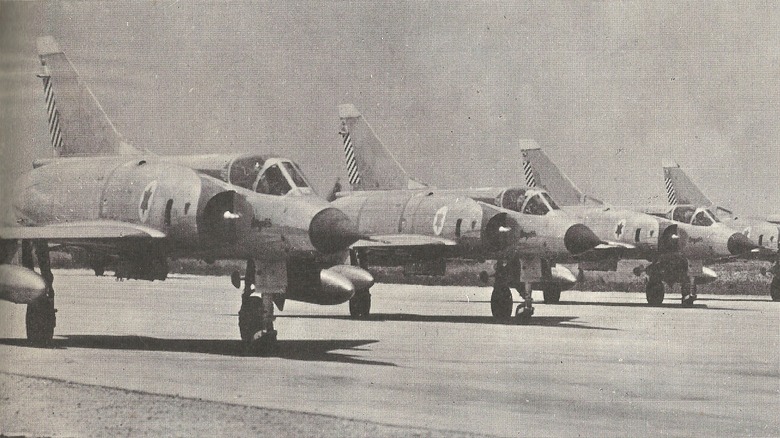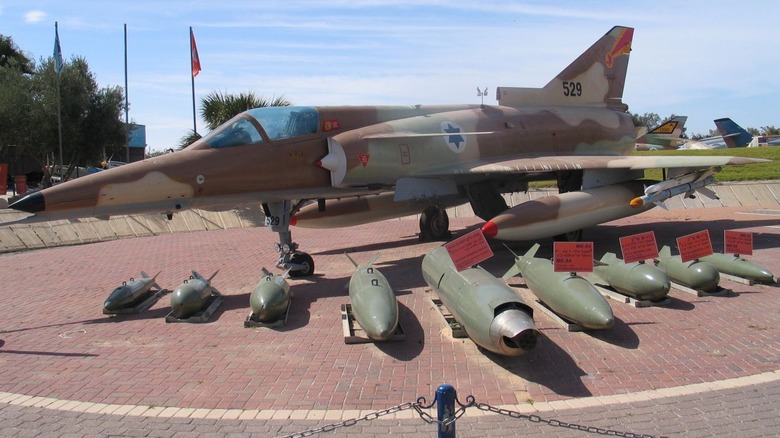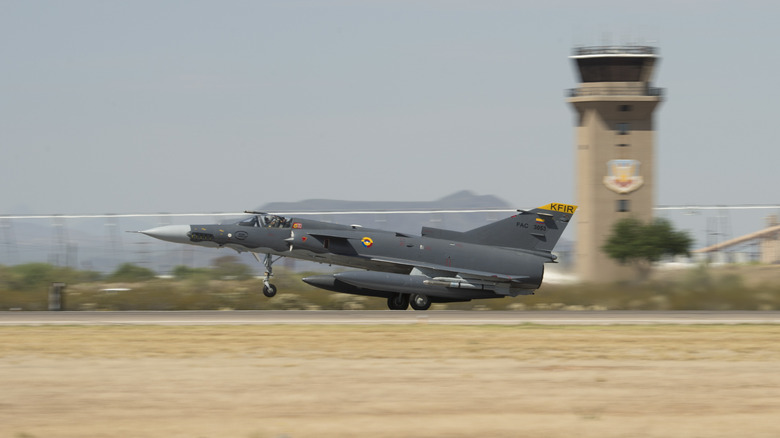Everything You Need To Know About The Kfir Fighter Jet
The Israeli Air Force (IAF) is one of the most capable, well-armed air forces today, thanks in part to the steady flow of advanced armaments from allies like the United States. However, Israel's homegrown defense industry has also played a pivotal role, with companies like Israeli Aerospace Industries (IAI), Rafael, and Elbit Systems producing top-of-the-line sensors and weapons that equip not only the Israel Defense Force (IDF) but also foreign armies. For instance, the widely used LITENING targeting pod, employed by the U.S. military on its fighter jets, is a product of Rafael's innovation.
This tradition of arms manufacturing didn't emerge overnight, though. One of the earliest catalysts that spurred Israeli investments in a robust defense industry was the story behind the IAI Kfir (Hebrew for "Lion Cub") — an Israel-built fighter jet that is essentially an unlicensed, homegrown copy of France's Dassault Mirage 5.
It may come as a surprise that the IDF, which now boasts fifth-generation fighter jets like the F-35 Lightning II (as the F-35I Adir) had to resort to boot-legging foreign aircraft. However, as the saying goes, necessity is the mother of invention: The pressing need for a new fighter jet, coupled with a geopolitical crisis, led to Israel producing the Kfir. Fortunately, this gamble paid off. Not only did the Kfir (and its predecessor, the Nesher) prove its mettle in some of the most intense dogfights in aerial combat history throughout the 1970s and 1980s, but the five-decade-old jet is still capable enough to remain flying today with many countries.
Israel creates their own jets when France impounds trade
During its formative years, the nascent Jewish state of Israel heavily relied on French arms and equipment to defend itself against its Arab neighbors. For its air force, the backbone of the service was the Dassault Mirage IIIC. It was on the wings of this French-made fighter jet that Israel ultimately triumphed in the air during the 1967 Six-Day War and 1967 Yom Kippur War. While the Mirage IIIC was an excellent air superiority fighter and interceptor, its short range made it inefficient at ground-attack roles. Consequently, in the mid-1960s, the IDF contracted Dassault to develop a variant of the Mirage 5. It would have been the perfect fighter bomber, powered by a more powerful engine and with the radar removed to save weight for more weapons.
But despite 50 Mirage 5s having been paid for and constructed, the shipment never arrived. In 1968, France imposed a total arms embargo on the country after Israeli special forces raided Lebanon. Just three years later, Israel started fielding a new jet that looked and performed exactly like a Mirage 5, in the form of the IAI Nesher (Vulture).
Some say Israeli spies had obtained the Mirage 5's blueprints, jumpstarting the production of a homegrown Mirage. (However, this story remains hotly debated.) Regardless, by the early 1970s, Israel had gained the capability to manufacture Mirage 5 airframes entirely on its own.
[Featured image by the IDF via Wikimedia Commons | Cropped and scaled | Public Domain]
The Kfir fighter jet enters the picture
The Nesher marked Israel's first attempt at reverse-engineering the Mirage 5. Although the jet performed admirably, securing numerous victories in dogfights during the Yom Kippur War, Israel had its sights set on a more advanced version. In 1974, it was phased out in favor of a new model: the IAI Kfir.
In most respects, the Kfir resembled the Nesher, bearing the likeness of the Mirage 5 upon which they were both based, coupled with Israeli avionics to ensure compatibility with Israeli air-to-air missiles such as the Shafrir. However, one critical factor set the Kfir apart from its predecessor: the engine.
Instead of the SNECMA Atar 9C engine, which produced around 13,240 pound-force of thrust on afterburner, the Kfir was equipped with an Israeli-built copy of the General Electric J79 turbojet (properly licensed this time), capable of delivering up to 17,900 pound-force of afterburning thrust. This extra power not only afforded the Kfir greater mobility (a trait the Nesher notoriously lacked) but also allowed the jet to carry more ordnance. In addition to a pair of integrated 30mm DEFA 533 cannons loaded with 140 rounds for each gun, the Kfir could also carry unguided and laser-guided bombs across nine hardpoints. Moreover, as mentioned earlier, in its interceptor configuration, it could be armed with both U.S.-made (AIM-9 Sidewinder) and Israeli AAMs (Shafrir, later Python).
[Image by Bukvoed via Wikimedia Commons | Cropped and scaled | CC BY-SA 3.0 DEED]
The Kfir is still flying today
Despite being over 50 years old, the IAI Kfir remains in service today. While Israel had retired the fleet from active duty in the late 1990s and sent them off to museums for display and airports as gate guardians, the Kfir is still a compelling value-packed option for many overseas countries whose military budgets don't allow for purchasing pricier, more advanced airframes. After all, it would certainly beat things like the oldest fighter jet still in service, the MiG-21.
Four customers for the jet stood out: Colombia, Sri Lanka, Ecuador, and even the U.S. For the latter, the Kfir was used as a simulated enemy fighter in the Navy's prestigious Strike Fighter Tactics Instructor program (or TOPGUN) for a time, under the designation F-21A Lion.
Interestingly, in the 1990s, the state-owned IAI privately explored the possibility of modernizing the Kfir for the export market. This aircraft, planned to take on the new name IAI Nammer ("Leopard"), would have retained the same airframe as the Kfir. However, everything else, including the cockpit, avionics, and engine, would have been stripped out and replaced with more modern versions. Unfortunately, the project ultimately went nowhere and was canceled. So, unless something extraordinary occurs, the Kfir is likely to be the last of the Mirage 5s in Israeli service.



